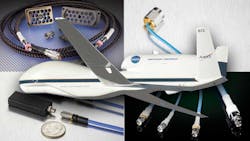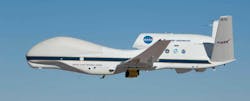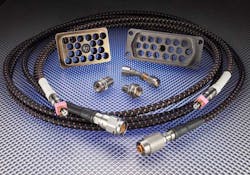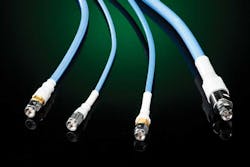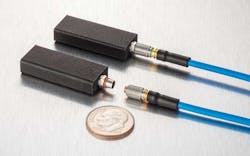Making Connections in Ruggedized UAVs
This article is part of TechXchange: Defense Electronics
Members can download this article in PDF format.
What you’ll learn:
- RF cables and connectors are mission-critical components of military UAVs
- Cable selection must weigh mechanical, electrical, and environmental requirements.
- Manufacturing tolerances for MIL-spec cables must be extremely tight.
Military unmanned aerial vehicles (UAVs) are growing in numbers and complexity, taking on more advanced payloads with multiple sensors. Modern battlefield UAVs do everything that human-piloted air vehicles and their avionics systems once did, including electronic warfare (EW), signal intelligence (SIGINT), and surveillance, often flying at high altitudes and high speeds. Many military UAVs are designed with modular configurations to install different subsystems for each mission to optimize results.
Whether in standard or modular formats, military UAVs rely strongly on their RF/microwave interconnections to keep all systems linked, including from the UAV to the ground through demanding operating conditions. Specifying RF connectors, cables, and cable assemblies for military UAVs, especially as they increase their use of mmWave frequencies, requires an intelligent balance of many factors to keep all systems connected under all conditions.
Military UAVs vary in size and complexity according to application and mission, with larger, fixed-wing vehicles flying at higher speeds and altitudes compared to smaller, fixed- and rotary-wing vehicles used at lower altitudes in commercial and industrial applications. One of the better-known high-altitude UAVs, the RQ-4 Global Hawk (Fig. 1), has flown at altitudes of 60,000 ft. and higher.
SWaP Considerations for UAV Components
Military requirements for size, weight, and power (SWaP) offer excellent guidance for component selection in UAVs because component weight and power consumption translate to a UAV’s operating range. In addition, components such as cables and connectors must fit into tight spaces and still be accessible for maintenance and measurement purposes.
UAVs contain many electronic parts and subsystems that must be interconnected, such as antennas, data recorders, radars, receivers, and transmitters. The cables and connectors provide the pathways for routing data, signals, and power throughout these subsystems. Any interruption in the pathways can be mission-critical, even fatal.
In general, space for components and payload in a UAV is limited, whether for military, commercial, or industrial use. The cables, connectors, and cable assemblies that provide interconnections within a UAV must meet tight space requirements while maintaining high performance and reliability. These interconnections have to satisfy challenging mechanical and electrical requirements within a UAV capable of enduring severe environmental conditions.
Choosing Cables and Interconnects: Where to Begin?
A practical starting point for sorting through coaxial cable interconnects is determining if they will even fit within the airframe. Smaller cables may fit where space is limited, adding little to the total weight of the UAV, but they may lack the performance to meet the electrical requirements of its electronic systems, so mechanical and electrical needs must be balanced.
Ideally, once installed, coaxial interconnections can be readily accessed for testing and maintenance purposes. UAVs with modular sensor systems will require access to interconnections for different modules used within the airframe.
Cable selection requires a balance of the mechanical, electrical, and environmental requirements for a UAV’s systems. Maximum cable diameter and weight are practical starting points when sorting through available cable solutions. The coaxial cable should exhibit low loss across a frequency range of interest, which will depend on the length and diameter of the cable.
The cable’s insertion loss and return loss (VSWR) also will be affected by the choice of connectors and how well the cable assembly and connectors are constructed. Low loss is particularly important for cable assemblies used at higher frequencies since signal power is limited at mmWave frequencies.
In addition to cable diameter and weight, the flexibility of a coaxial cable assembly is essential when determining whether a particular assembly can fit the needs of a UAV’s interconnections. Interconnect flexibility can be gauged in terms of its minimum bend radius, which is a function of a cable’s construction. Minimum bend radius effectively defines the space required for the smallest change in a cable’s direction.
Weathering High-Stress Conditions
High-frequency interconnect cable assemblies for military UAVs face severe conditions while in flight due to changing weather and stresses caused by high-speed operation. Some UAVs developed for high-altitude operation include hypersonic capabilities with speeds reaching Mach 5 and above. These speeds result in high-temperature environments for the UAV’s electronic components and systems, which must operate reliably at these higher temperatures.
Because the interconnections are such critical components, cables and connectors for military-grade UAVs are designed for operating temperatures as high as +300°C and total operating temperature ranges as wide as −65 to +300°C. Even the 300°C limit is being challenged; thus, Times Microwave Systems (TMS) has been asked to develop materials for its cables and connectors to handle these new challenges.
RF/microwave interconnections in military UAVs, especially those with phased-array antennas, require high phase stability with temperature. Phase-matched cable assemblies are typically used in antenna systems where phase is used as a beamforming and tuning parameter and in multiple-input/multiple-output (MIMO) antennas that combine the contributions of multiple antennas to send and receive high-frequency signals, often with wide modulation bandwidths.
High-altitude (typically 50,000 ft. or more above sea level) UAVs often operate in conditions that expose their components to near-vacuum environments, resulting in moisture-absorption problems when it returns to sea level. This “water in the cable” affects the interconnect amplitude and phase characteristics of the cable’s conductive metals and dielectric insulators and may result in significant degradation and failure of an electronic systems. As a preventative measure, coaxial cables designed for military UAVs, especially those for high-altitude operation, usually include some form of environmental seal against the effects of vacuum-like environments.
Adding Connectors
The mechanical, electrical, and environmental performance levels achieved by a UAV’s coaxial cables also must include its connectors as they contribute to the SWaP levels. Connectors are typically designed for ease of installation and minimal mechanical and electrical performance degradation. For UAV applications, the high-performance levels must be maintained at high shock and vibration levels.
The quality of a coaxial connector’s machined components, as well as performance and reliability, are impacted by how well the connector is attached to the cable and the effectiveness of its locking mechanism in a mated pair of connectors. Connectors can be soldered or crimped to a cable, with soldering the more labor-intensive approach but providing a robust mechanical attachment with little performance degradation over time. An effective plated finish on a coaxial connector also can contribute to reliable and consistent long-term performance.
Due to the modular architecture of some UAVs, some coaxial connectors must endure many mate-demate cycles for changing of function modules within the UAV. In such cases, a connector’s mate-demate lifetime needs to be evaluated along with its mechanical, electrical, and environmental performance parameters to achieve the best fit within a particular UAV. Oftentimes, high-frequency, high-performance blind-mate connectors are used in UAVs for this purpose.
Seeking Solutions
Practical UAV interconnection solutions are typically available as cables or cable assemblies constructed according to precise lengths and designated connectors. For example, TMS’s MILTECH flexible cable assemblies (Fig. 2) from Times Microwave Systems feature excellent shock and vibration resistance and good phase stability over a wide operating temperature range (−65 to +200°C). They’re manufactured to applicable military standards with tight cable/connector interface control to achieve the hermetic seal needed for high-altitude flight.
The cables are constructed with polytetrafluoroethylene (PTFE) dielectric, a solid silver-plated copper center conductor, and a silver-plated copper shield for protection from electromagnetic interference (EMI). Furthermore, they’re factory-terminated with a variety of coaxial connectors.
To meet the tight space requirements of different UAV systems, MILTECH cables come in various sizes/weights, including 0.130-in. (3.30-mm) diameter cables with 0.650-in. minimum bend radius and 0.175-in. (4.45-mm) diameter cables with 0.875-in. minimum bend radius. The smaller-diameter cables can be terminated with 2.4- or 2.9-mm connectors for use at mmWave frequencies. The cables feature high moisture resistance and vibration resistance according to MIL-STD-202 requirements and high shock resistance per MIL-E-5272 requirements.
For tight UAV fits requiring cables bent close to the connector, TMS’s INSTABEND 047 cable assemblies (Fig. 3) provide low-loss propagation of signals up to 62 GHz in the tightest spaces. To ensure high-quality attachment of connectors to cable, they’re only available as complete assemblies.
An INSTABEND 047 cable assembly with an outside diameter of 0.10 in. (2.67 mm) provides a minimum bend radius of 0.3 in. (6.4 mm). Light in weight for UAVs, these cable assemblies weigh only 0.01 lb./ft. (0.02 kg/m) and are available with several different connectors depending on frequency range. They handle temperatures from −60 to +125°C, are shielded to −90 dBc, and rated for voltages to 100 V.
When phase must be tightly controlled, PhaseTrack cables and cable assemblies developed by Times Microwave Systems are well-suited for that parameter, coming in a variety of diameters with different connectors. A 0.108-in. diameter cable (Fig. 4) features a cutoff frequency of 80 GHz and a minimum bend radius of 0.550 in. The cable is constructed with proprietary TF4 dielectric and doesn’t suffer the phase variations with temperature common to cables with PTFE dielectric.
PhaseTrack cable assemblies fit ground, sea, airborne, and space platforms. They’re available in many versions, including a silicon-dioxide (SiO2) dielectric for applications with temperatures exceeding +1000°C.
Rugged Connectors
Maintaining connections under high shock and vibration levels common to a UAV while being easy to mate requires a coaxial connector with a simple but effective locking mechanism. The TLMP push-on locking connector from Times Microwave Systems (Fig. 5) was designed with the small form factor of the popular SMP push-on connector but with improved mechanical, electrical, and environmental performance.
The TLMP connector, which is usable to 60 GHz, has a unique mechanical design that supports high-pulsed-power, high-voltage applications. Its latching mechanism achieves improved mating retention compared to an SMP connector even in the high shock and vibration environments of military UAVs. The connector’s slots are entirely covered with its mating part for improved EMI and EMC performance compared to an SMP connector. Connections must maintain high EMI and low levels of signal leakage to prevent an adversary from identifying a military drone in flight.
For UAV interconnect applications that don’t require a hermetic seal or enhanced phase stability, Times Microwave Systems’ LMR and TCA cables and cable assemblies can be practical options. LMR cable assemblies provide flexibility to enable tight fits while LMR LW cables feature an aluminum braid shield for effective shielding in low-weight cable assemblies usable through 8 GHz. TCA cables and connectors have long served commercial avionics systems as flexible interconnect solutions, offering a combination of light weight and durability through 5 GHz and higher.
Read more articles in TechXchange: Defense Electronics
About the Author
Dave Murray
Senior Applications Engineer, Times Microwave Systems
Dave Murray, a Senior Applications Engineer at Times Microwave Systems (TMS) based in Arizona, is responsible for training new applications engineers. Dave joined TMS in 1995 as Western Regional Sales Engineer. Since then, Dave has been closely involved with aerospace products and projects. He’s been instrumental in leading the F-35 project and nurturing customer relationships.
With 45 years of experience and expertise, Dave has led development teams on all aspects of coaxial and RF system design and integration into numerous aircraft. Prior to joining TMS, Dave held positions at W.L. Gore & Associates and Southwest Microwave and taught undergraduate math/science at the University of Colorado Denver, CTU, and Park College Business School.
Dave holds a BSEE from Colorado Technical University. He lives in Arizona with his wife of 46 years and enjoys spending time with his growing family of four sons, six grandchildren, and one great grandson.
